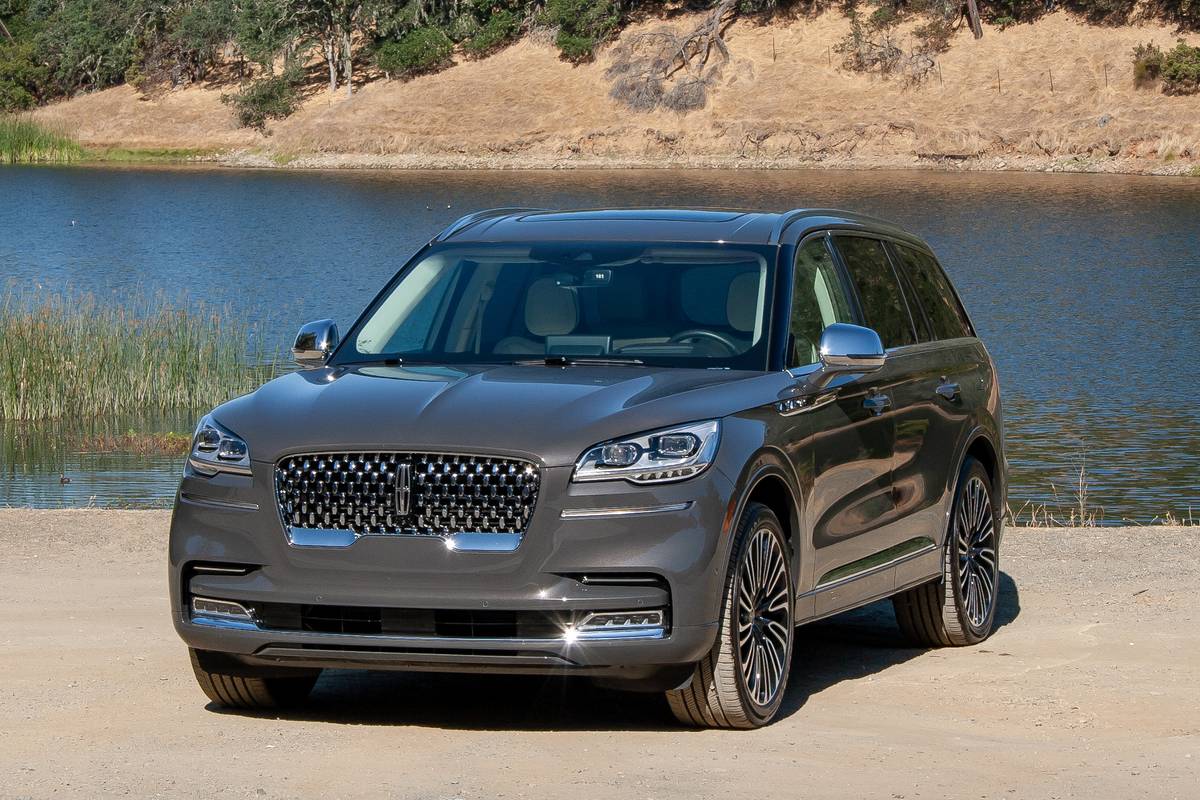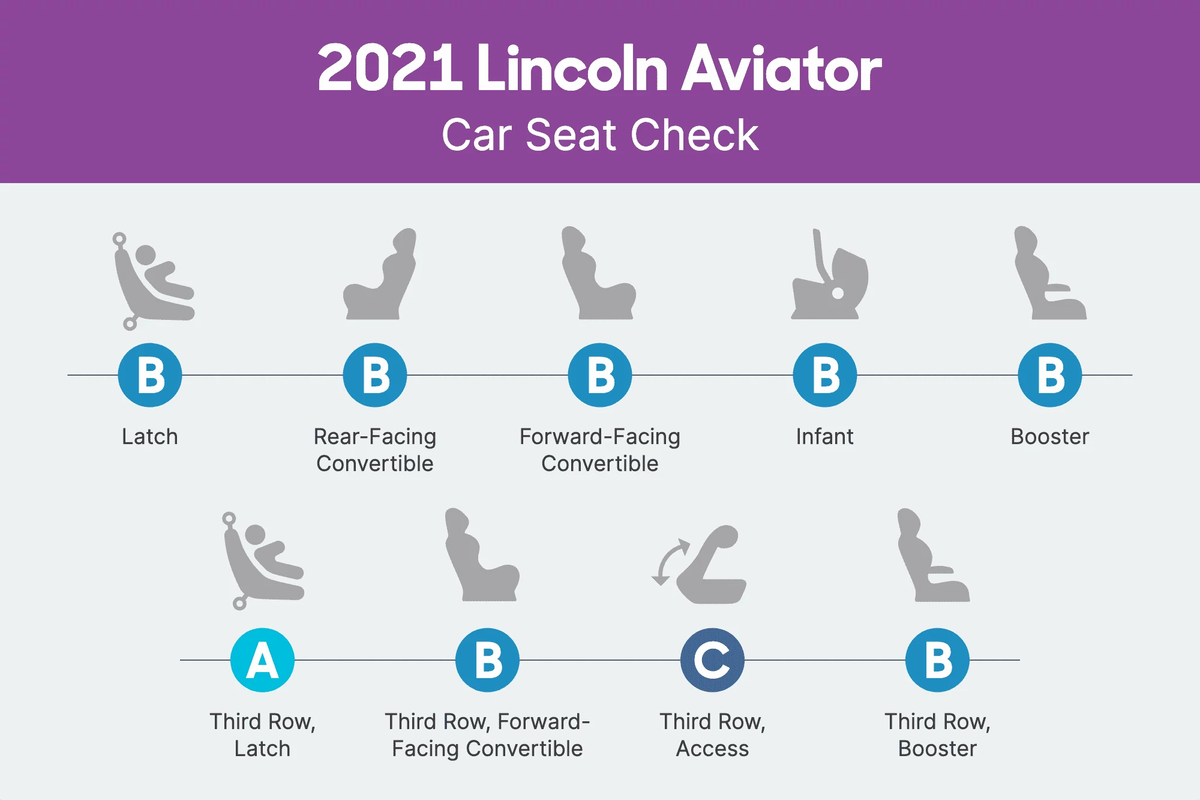Editor’s note: This Car Seat Check was written in October 2020 about the 2020 Lincoln Aviator. Little of substance has changed with this year’s model. See what’s new for 2021 or see the models compared.
The verdict: Lincoln’s Aviator sits below the full-size Navigator in the automaker’s lineup. This three-row SUV had ample room for two car seats in its second row when we tested it, though we were left wanting for third-row legroom. For this car seat check, we tested a high-end Reserve trim with second-row bucket seats.
Does it fit three car seats? No.
Take a look at how the Latch system and each car seat scored below in our Car Seat Check of the 2020 Lincoln Aviator.
Related: Search Car Seat Checks
A Grade
- Latch, third row: In the third row, there are two sets of lower anchors; they’re exposed for easy access and connection. There are two top tether anchors on the seatback that are clearly marked and easy to use.
B Grade
- Latch, second row: The two sets of anchors sit in pockets in the leather upholstery, which must be opened to expose them. This isn’t difficult, but it’s an extra step. Two clearly marked top tether anchors sit on the seatback.
- Infant: Installation was OK and our 5-foot, 6-inch front passenger had ample legroom after the infant seat was installed.
- Rear-facing convertible: Again, installation was fine and there were no room issues.
- Forward-facing convertible: There was no need to raise the head restraint. Connection was again OK — once we fumbled through the upholstery pocket to expose the Latch anchors. Connecting to the top tether anchor was easy.
- Booster: Again, there was no need to raise the head restraint to ensure the booster sits flush against the seatback. The buckles are floppy, which may make them hard for kids to grasp, but they can be routed through a strap in the leather so they don’t flop behind the booster.
- Forward-facing convertible, third row: The fixed head restraint is skinny, so it doesn’t interfere with fit. Connecting to the lower anchors and top tether anchor was easy. There’s not a lot of third-row legroom, however. If people in the second row are tall and have the seats set all the way back, there’s not enough third-row legroom.
- Booster, third row: Again, the fixed head restraint is small enough so as to not interfere with the booster sitting flat against the seatback. The third row’s stable buckles should be easy for kids to grasp and use. There’s not a lot of third-row legroom, however. If people in the second row are tall and have the seats set all the way back, legroom will be a problem in the third row.
C Grade
- Third-row access: There’s a big storage console between the second-row captain’s chairs, which makes it tough to access the third row. There’s a button on the captain’s chair seatback that slides the seat forward to open access to the third row, but that won’t work with car seats installed and the opening is small. The step-in height is also pretty tall.
Grading Scale
A: Plenty of room for the car seat and the child; doesn’t impact driver or front passenger legroom. Easy to find and connect to Latch and tether anchors. No fit issues involving head restraint or seat contouring. Easy access to the third row.
B: One room, fit or connection issue. Some problems accessing the third row when available.
C: Marginal room plus one fit or connection issue. Difficult to access the third row when available.
D: Insufficient room, plus multiple fit or connection issues.
F: Does not fit or is unsafe.
About Cars.com’s Car Seat Checks
Editors Jennifer Geiger and Jennifer Newman are certified child safety seat installation technicians.
For the Car Seat Check, we use a Chicco KeyFit 30 infant-safety seat, a Graco Contender 65 convertible seat and Graco TurboBooster seat. The front seats are adjusted for a 6-foot driver and a shorter passenger. The three child seats are installed in the second row. The booster seat sits behind the driver’s seat, and the infant and convertible seats are installed behind the front passenger seat.
We also install the forward-facing convertible in the second row’s middle seat with the booster and infant seat in the outboard seats to see if three car seats will fit; a child sitting in the booster seat must be able to reach the seat belt buckle. If there’s a third row, we install the booster seat and a forward-facing convertible. Learn more about how we conduct our Car Seat Checks.
Parents should also remember that they can use the Latch system or a seat belt to install a car seat, and that Latch anchors have a weight limit of 65 pounds, including the weight of the child and the weight of the seat itself.
Cars.com’s Editorial department is your source for automotive news and reviews. In line with Cars.com’s long-standing ethics policy, editors and reviewers don’t accept gifts or free trips from automakers. The Editorial department is independent of Cars.com’s advertising, sales and sponsored content departments.
Source: Read Full Article


